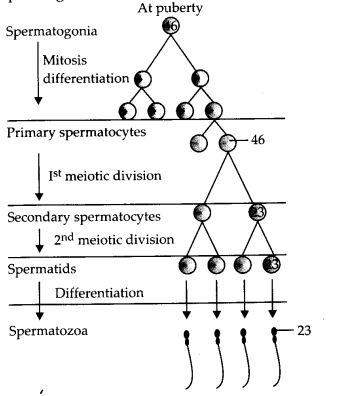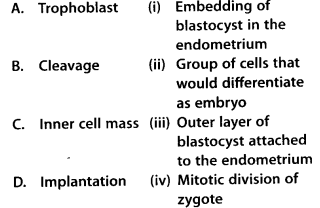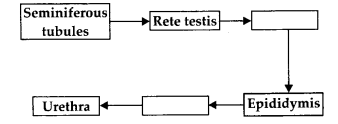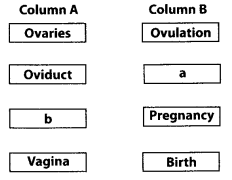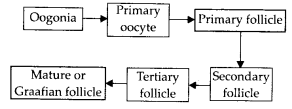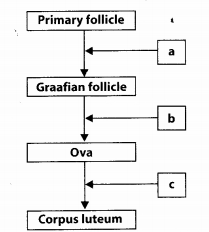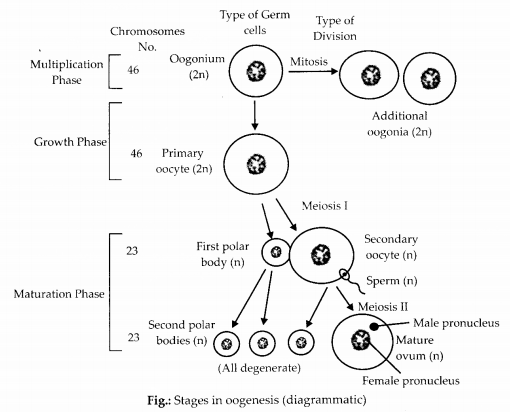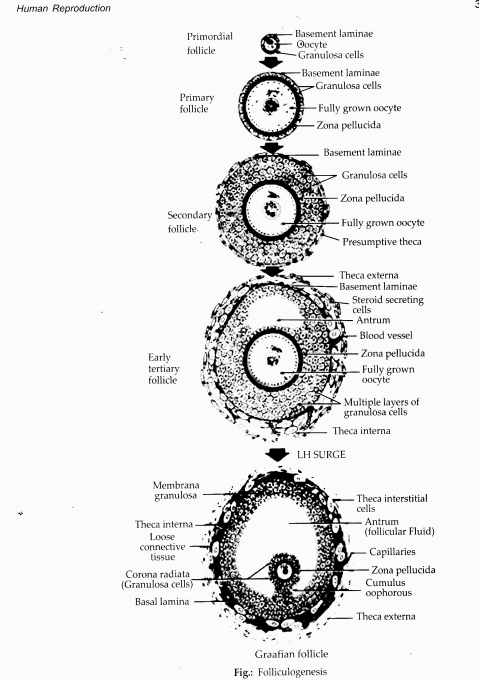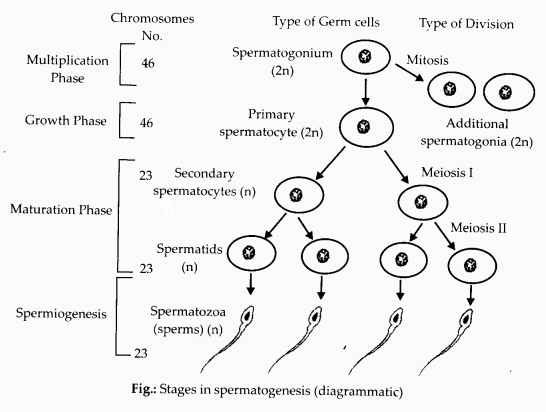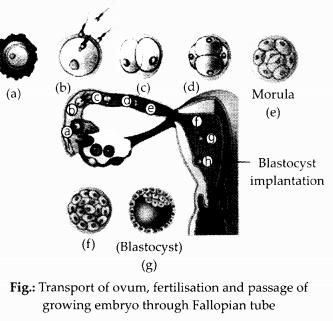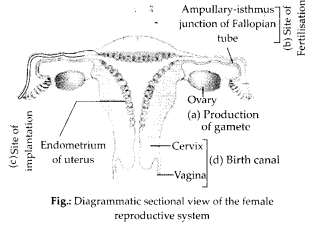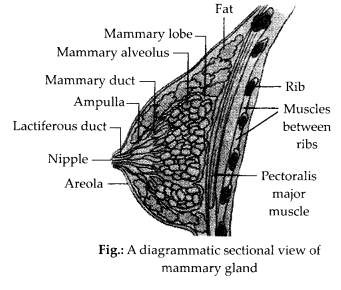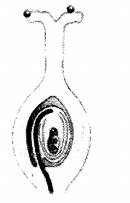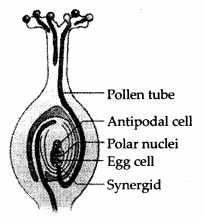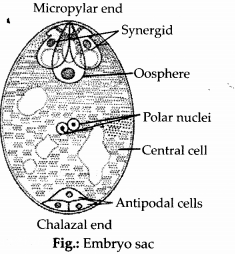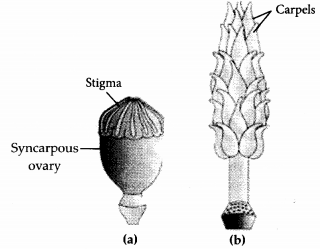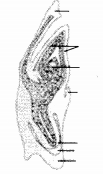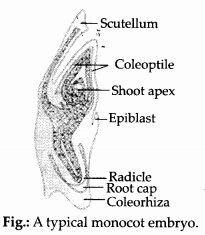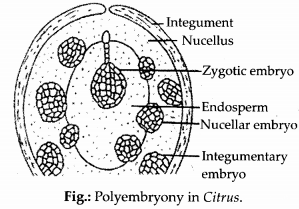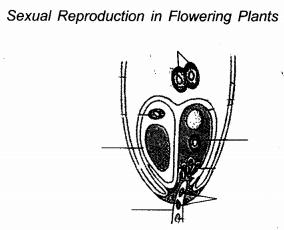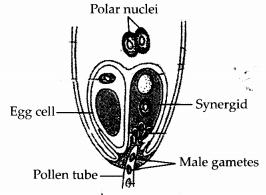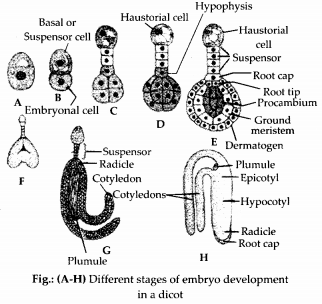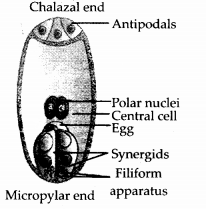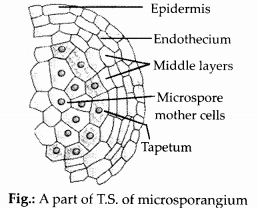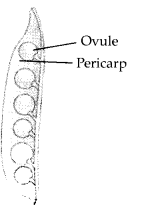NCERT Exemplar Solutions for Class 12 Biology chapter 4 Reproductive Health
These Solutions are part of NCERT Exemplar Solutions for Class 12 Biology. Here we have given NCERT Exemplar Solutions for Class 12 Biology chapter 4 Reproductive Health
Multiple Choice Questions
Question 1.
The method of directly injecting a sperm into ovum in assisted reproductive technology is called
(a) GIFT
(b) ZIFT
(c) ICSI
(d) ET.
Answer:
(c) : ICSI or Intra Cytoplasmic Sperm Injection is one of the techniques of Assisted Reproductive Technology (ART) that helps couples to overcome their infertility. In ICSI, sperm is directly injected into ovum, in vitro to form zygote, which is implanted through ZIFT into woman.
Question 2.
Increased IMR and decreased MMR in a population will
(a) cause rapid increase in growth rate
(b) result in decline in growth rate
(c) not cause significant change in growth rate
(d) result in an explosive population/exp.
Answer:
(b) : If there is an increase in infant mortality rate (IMR) and decrease in maternal mortality rate (MMR), mothers are available to give birth to infants but the infants’ survival rate is low, which will ultimately hinder the growth rate of that particular population.
Question 3.
Intensely lactating mothers do not generally conceive due to the
(a) suppression of gonadotropins
(b) hypersecretion of gonadotropins
(c) suppression of gametic transport
(d) suppression of fertilisation.
Answer:
(a) : Presence of prolactin hormone in the blood of lactating mothers suppresses the release of gonadotropins (FSH and LH) from the pituitary gland. Gonadotropins are required for ovulation to occur. Thus, in the absence of, gonadotropins, ovum is not released and hence chances of fertilisation are nil upto 6 months following parturition (if the mother is regularly breast-feeding). Therefore, intensely lactating mothers do not generally conceive.
Question 4.
Sterilisation techniques are generally fool proof methods of contraception with least side effects. Yet, this is the last option for the couples because
(1) it is almost irreversible
(2) of the misconception that it will reduce sexual urge/drive
(3) it is a surgical procedure
(4) of lack of sufficient facilities in many parts of the country
Choose the correct option.
(a) (i) and (iii)
(b) (ii) and (iii)
(c) (ii) and (iv)
(d) (i), (ii), (iii) and (iv)
Answer:
(d) : Sterilisation techniques are surgical procedures where, in males, vas deferens are cut and tied and in females, Fallopian tubes are cut and tied, preventing gamete transport.
Even though it is very effective it is often used as a last option by most couples. One, because it is almost irreversible. Second, because of some misconceptions like absence of ejaculation and lowering of sexual urge.Third, because it is a surgical procedure, there are certain risk of infection. Last but not least,
there are lack of sufficient facilities in many parts of our country (e.g., lack of hygiene, lack of qualified personnel etc.)
Question 5.
A national level approach to build up a reproductively healthy society was taken up in our country in
(a) 1950s
(b) 1960s
(c) 1980s
(d) 1990s
Answer:
(a) : The national level approach towards building a reproductively healthy society began with ‘family planning’ programmes in 1951. Over last 6 decades many other programmes have been started. In 2000, National Population Policy was launched and in 2005, National Rural Health Mission (NRHM) was launched, with the aim of revamping the public health services in rural areas. Janani Suraksha Yojana has also been launched which includes conditional cash transfer. Other improved programmes are also initiated with the term of ‘Reproductive and child Health Care’ (RCH). Launching a number of schemes will benefit only when people are aware of them and those working at the various stages of implementation are doing their work honestly and with right intention.
Question 6.
Emergency contraceptives are effective if used within
(a) 72 hrs of coitus
(b) 72 hrs of ovulation
(c) 72 hrs of menstruation
(d) 72 hrs of implantation.
Answer:
(a)
Question 7.
Choose the right one among the statements given below.
(a) lUDs are generally inserted by the user herself.
(b) lUDs increase phagocytosis reaction in the uterus.
(c) lUDs suppress gametogenesis.
(d) lUDs once inserted need not be replaced.
Answer:
(b) : Copper releasing IUDs (CuT, multiload) increase phagocytosis of sperms within the uterus and the Cu ions released suppress sperm motility and the fertilising capacity of sperms. The hormone releasing IUDs (progestaserf, LNG-20), make the uterus unsuitable for implantation and the cervix hostile to the sperms. IUDs are inserted and removed by trained doctors and they are ideal contraceptives for the females. IUDs, once inserted can be there for a long period of time (even years), especially, copper releasing IUDs. But eventually they need to be removed and replaced, as they are foreign to the body. Fertility returns, once IUDs are removed.
Question 8.
Following statements are given regarding MTP. Choose the correct options given below.
(1) MTPs are generally advised during first trimester.
(2) MTPs are used as a contraceptive method.
(3) MTPs are always surgical.
(4) MTPs require the assistance of qualified medical personnel.
(a) (ii) and (iii)
(b) (i) and (iii)
(c) (i) and (iv)
(d) (i) and (ii)
Answer:
(c) : Voluntary termination of pregnancy before full term is called Medical Termination of Pregnancy (MTP). It is less riskier during first trimester (upto 12th week) and requires assistance of qualified medical personnel. Surgical methods of termination of pregnancy include vacuum aspiration of the products of conception through an intra-uterine cannula, etc. It can also be induced using chemical drugs, e.g., mifepristone and prostaglandin. These drugs are taken only in the supervision of qualified medical personnel.
Question 9.
From the sexually transmitted diseases mentioned below, identify the one which does not specifically affect the sex organs.
(a) Syphilis
(b) AIDS
(c) Gonorrhoea
(d) Genital warts
Answer:
(b) : AIDS (Acquired Immune Deficiency Syndrome) is caused by HIV (Human Immunodeficiency Virus, a retrovirus). It mainly affects the T-helper lymphocytes by infecting them. There is generally a long time lag between infection and occurrence of symptoms. Because of lowering of T-helper lymphocyte count, the person becomes vulnerable to infectious microorganisms, that otherwise, wouldn’t have caused any disease(opportunistic infection). A major example of this is tuberculosis. Weight loss also occurs in such persons.
Question 10.
Condoms are one of the most popular contraceptives because of the following reasons.
(a) These are effective barriers for insemination.
(b) They do not interfere with coital act.
(c) These help in reducing the risk of STDs.
(d) All of the above.
Answer:
(d)
Question 11.
Choose the correct statement regarding the ZIFT procedure.
(a) Ova collected from a female donor are transferred to the Fallopian tube to facilitate zygote formation.
(b) Zygote is collected from a female donor and transferred to the Fallopian tube.
(c) Zygote is collected from a female donor and transferred to the uterus.
(d) Ova collected from a female donor and transferred to the uterus.
Answer:
(None) : In test tube baby programme, ovum from donor female/wife and sperm from donor male/husband are induced to form zygote in the laboratory. The zygote is allowed to divide upto 8 blastomeres in the laboratory. Zygote or early embryo is then transferred into the Fallopian tube. This technique is called ZIFT (Zygote Intra Fallopian Transfer).
Question 12.
The correct surgical procedure as a contraceptive method is
(a) ovariectomy
(b) hysterectomy
(c) vasectomy
(d) Casttation
Answer:
(c) : Vasectomy is a surgical contraception method performed in males. In vasectomy a small part of the vas deferens is removed or tied up through a small cut on the scrotum.
Question 13.
Diaphragms are contraceptive devices used by the females. Choose the correct option from the statements given below.
(1) They are introduced into the uterus.
(2) They are placed to cover the cervical region.
(3) They act as physical barriers for sperm entry.
(4) They act as spermicidal agents.
(a) (i) and (ii)
(b) (i) and (iii)
(c) (ii) and (iii)
(d) (iii) and (iv)
Answer:
(c) : Diaphragms are soft, hemispherical rubber cups fitted inside the vagina over the neck (cervix) of the uterus acting as physical barrier for sperm entry. When combined with the use of a chemical spermicide, they provide reliable contraception.
Very Short Answer Type Questions
Question 1.
Reproductive health refers only to healthy reproductive functions. Comment.
Answer:
According to WHO (World” Health Organisation), reproductive health means total well being of a person in all aspects of reproduction, i.e. physical, emotional, behavioral and social. It does not only refer to healthy reproductive functions.
Question 2.
Comment on the Reproductive and Child Health Care programme of the government to improve the reproductive health of the people
Answer:
RCH (Reproductive and Child Health Care) Programme aims at improving reproductive health of the society. Various measures undertaken by this programme include creating awareness among people about various reproduction related aspects, providing facilities and support for building up a reproductively healthy society, educating fertile couples about birth control measures, prenatal and postnatal care of mother and child, etc.
Question 3.
The present population growth rate in India is alarming. Suggest ways to check it.
Answer:
Ways to check present population growth rate are:
(1) Educating people by various audiovisual means about the advantages of small families.
(2) Making them aware of ill effects of overpopulation.
(3) Implementing family planning programmes sincerely to achieve zero population growth.
(4) Increasing marriageable age limit.
Question 4.
STDscan be considered as self-invited diseases. Comment.
Answer:
Sexually Transmitted Diseases (STDs) can be considered as self-invited diseases because one could be free of these by following simple precautions. These are as follows:
- Avoid sex with unknown partners/multiple partners.
- Always use condoms during coitus.
- In case of doubt, one should go to a doctor for early detection and complete treatment.
Question 5.
Suggest the reproduction related aspects in which counselling should be provided at the school level.
Answer:
Introduction of sex education in schools is another step to give right information to the young minds about reproductive organs, accessory organs of reproduction, secondary sexual characters, adolescence and related changes, safe and hygienic sexual practices, sexually transmitted diseases, birth control methods etc. This knowledge will save them from myths and misconceptions about sex related aspects.
Question 6.
Mention the primary aim of the “Assisted Reproductive Technology” (ART) programme.
Answer:
ART (Assisted Reproductive Technology) programme assists the infertile couples to have children through some special techniques. It includes various programmes like test tube babies, ZIFT, GIFT, AIT, ICSI etc.
Question 7.
What is the significance of progesterone- estrogen combination as a contraceptive measure?
Answer:
Birth control pills like Mala D and Mala N have progesterone-estrogen combinations, and are commonly called combination pills. They inhibit ovulation and implantation.
Question 8.
Strict conditions are to be followed in medical termination of pregnancy (MTP) procedures. Mention two reasons.
Answer:
Two reasons for following strict conditions in medical termination of pregnancy (MTPs) are:
- It is being misused to abort even the normal female foetuses.
- MTP performed after first trimester i.e., 12 weeks of pregnancy becomes riskier as foetus becomes more deeply associated with uterine tissue of mother.
Question 9.
Males in whom testes fail to descend to the scrotum are generally infertile. Why?
Answer:
Sperms need slightly lower temperature than body temperature to survive, which is provided by scrotal sac. If testes fail to descend into scrotum, sperms will get killed at high temperature present in abdomen and the person will become infertile.
Question 10.
Mention two advantages of lactational amenorrhea as a contraceptive method.
Answer:
Two advantages of lactational amenorrhea as a contraceptive method are as follows:
- During intense lactation after parturition, mother does not undergo menstruation and ovulation as high levels of prolactin suppresses ‘ secretion of gonadotropins from anterior pituitary.
- No medicines or devices are used in this method thus, side effects are almost nil.
Short Answer Type Questions
Question 1.
Suggest some important steps that you would recommend to be taken to improve the reproductive health standards in India.
Answer:
Following measures are needed to be undertaken to improve the reproductive health standards in India :
- Implementation of RCH (Reproductive and .Child Health Care) and family planning programmes.
- To follow child immunisation programme.
- Introduction of sex education in schools to remove myths and misconceptions about sex related issues.
- To impose statutory ban on amniocentesis and to check female foeticide.
- To educate people about various health related programmes and family planning programmes.
- To control sexually transmitted diseases.
- Create fertility clinics to diagnose and treat disorders related to infertility.
Question 2.
The procedure of GIFT involves the transfer of female gamete to the Fallopian tube. Can gametes be transferred to the uterus to achieve the same result? Explain.
Answer:
The results will not be the same if gametes are introduced into the uterus, instead of Fallopian tube in the procedure of GIFT. This can be explained as follows. The Fallopian tube and its micro environment are ideal for fertilisation and early embryo development. The anatomy and physiology of Fallopian tube plays an important role in egg transport and fertilisation. Zygote formed as a result of fertilisation, divides to form embryo. Complex interactions take place between oviducal epithelium and the embryo. Human oviducal cells are known to secrete growth factors, cytokines and embryotrophic factors (ETFs) that enhance and support the development of the preimplantation embryos. On the other hand, the uterine environment is not appropriate for the survival of the gametes, they may undergo degeneration or get phagocytosed in uterus and zygote formation will not be achieved.
Question 3.
Copper ions-releasing lUDs are more efficient than non-medicated methods. Why?
Answer:
Copper releasing IUDs like Cu-T, Cu-7, multi load 375 etc., are more efficient than non- medicated methods because non-medicated methods simply act as barriers for sperm entry into the reproductive tract of female and are not fool proof whereas copper ion releasing IUDs release Cu ions which suppress the sperm motility and fertilising capacity of the sperms and act as better contraceptives.
Question 4.
What are the probable factors that contributed to population explosion in India?
Answer:
Factors favouring population explosion are :
- Lack of education in developing countries.
- Lack of entertainment and gainful employment in under-developed countries.
- Early marriage, child labour.
- Desire of male child, traditional religious beliefs etc.
Question 5..
Briefly explain IVE and ET. What are the conditions in which these methods are advised?
Answer:
In 1VF (In Vitro Fertilisation), fertilisation takes place outside the body of female in similar conditions as that in the body followed by E.T (Embryo Transfer). It is performed as follows:
- Ova from the wife/donor female and sperms from husband/donor male are collected in hygienic manner.
- Both ova and sperms are kept in culture medium under aseptic conditions.
- Gametes are induced to fuse, and form zygote under simulated conditions.
In ET (Embryo Transfer) technique, developing embryo is transferred from culture medium to female reproductive tract. It is performed as follows:
- Zygote is induced in culture medium to develop.
- Endometrium is stimulated to be prepared for implantation.
- Embryo is transferred to Fallopian tubes in 8 celled condition or transferred to uterus when it is at 16-32 celled stage. When in a woman normal conception is not possible because of blocked oviducts or spermicidal secretions in the vagina or when a woman cannot produce ova or man cannot produce sperms. In such conditions these methods are advised.
Question 6.
What are the advantages of natural methods of contraception over artificial methods?
Answer:
Natural methods of contraception include rhythm method, coitus interruptus and lactational amenorrhea. These methods do not involve use of any contraceptive or any chemical or surgery therefore, do not have any side effects. On the other hand, artificial methods of contraception which include IUDs, oral pills etc., have certain drawbacks. IUDs may cause occasional haemorrhage or infections. Combined oral pills generally have side effects like nausea, breast tenderness, weight gain, breakthrough bleeding and melasma etc.
Question 7.
What are the conditions in which medical termination of pregnancy is advised?
Answer:
The conditions in which medical termination of pregnancy is advised are as follows :
- To get rid of unwanted pregnancy either due to unprotected intercourse or failure of the contraceptive used or rape.
- If baby is suffering from an incurable and congenital developmental defect.
- If continuation of pregnancy is harmful or even fatal either to mother, or to foetus or both.
Question 8.
Comment on the essential features required for an ideal contraceptive.
Answer:
An ideal contraceptive should be:
- User friendly
- Easily available and cheaper
- Effective but also reversible
- With no or least side effects
- Should not interfere with the sexual act.
Question 9.
All reproductive tract infections RTIs are STDs, but all STDs are not RTIs. Justify with example.
Answer:
STDs are sexually transmitted diseases and include gonorrhoea, syphilis, genital warts, chlamydiasis, hepatitis B and AIDS. Hepatitis B and AIDS are not RTFs because they do not cause any infection in the reproductive tract but are spread through sexual means, whereas other diseases are STDs as well as RTIs.
Long Answer Type Questions
Question 1.
What are the Assisted Reproductive Techniques practiced to help infertile couples? Describe any three techniques.
Answer:
Assisted reproductive techniques are employed to diagnose and treat the infertile couples to have children. A few techniques are described as follows:
(1) Test tube babies : In this technique the fusion of ovum and sperm is done outside the body of the female to form a zygote Which is allowed to divide to form an embryo. This embryo is- then implanted in the uterus, where it develops into a foetus.
(2) Gamete Intra Fallopian Transfer (GIFT) : This method is vised in females, who can not produce ova, hut can provide suitable environment for fertilisation and further development of embryo in the oviducts. In such cases, ovum from the donor female is introduced into the Fallopian tube of such female. Such women accept sperms from their husbands during copulation.
(3) Intra Cytoplasmic Sperm Injection (ICSI) : It is another specialised technique to form an embryo in laboratory in which a I sperm is directly injected into the ovum placed in a nutrient broth. The zygote or early embryo is later transferred to the Fallopian tube of woman by ZIFT.
Question 2.
Discuss the mode of action and advantages/disadvantages of hormonal contraceptives.
Answer:
Various hormonal contraceptives are:
- Hormone releasing IUDs
- Oral pills
- Implants
- Hormone injections
(1) Hormone releasing IUDs – Hormone releasing IUDs include progestasert and LNG-20. They turn the cervix hostile to spermatozoa and bring changes in the uterus making it unsuitable for implantation.
(2) Oral pills – They contain progestin (progesterone like synthetic hormone) alone or a combination of synthetic progesterone and oestrogen. They inhibit the secretion of FSH and LH from anterior pituitary and inhibit ovulation and implantation. They also retard the entry of sperms in the uterus by changing the quality of cervical mucus.
(3) Subcutaneous implants – In this contraception method, six matchstick sized capsules containing synthetic progesterone are inserted under the skin of inner arm above the elbow. It acts similarly to oral contraceptives by blocking ovulation and thickening the cervical mucus to prevent sperm transport.
(4) Hormone injections – These are pro gesterone injections which are given once every 3 months and release hormone slowly and prevent ovulation. follows :
Various contraceptive techniques play significant role in checking the uncontrolled growth of human population. They are required to prevent pregnancy.
Disadvantages of hormonal contraceptives are as follows :
These hormone releasing contraceptives especially have many side effects. Use of IUDs possesses the risk of perforation of uterus and infection. Oral contraceptives can cause nausea, weight gain, breast tenderness, breakthrough bleeding, high blood pressure and melasma.
Question 3.
STDs are a threat to reproductive health. Describe any two such diseases and suggest preventive measures.
Answer:
Sexually transmitted disease (STDs) are threat to reproductive health. They are infectious, communicable and acquired diseases. They may lead to various complications like PID (pelvic inflammatory diseases), abortions, still birth, ectopic pregnancies, infertility or even cancer of reproductive tract. Some sexually transmitted diseases are discussed as follows :
(1) AIDS — It is caused by Human Immunodeficiency Virus (HIV)
Symptoms – Fever, lethargy, pharyngitis, weight loss, nausea, headache, rashes etc.
HIV attacks helper T-lymphocytes. The patient gets immune deficiency and he/ she is unable to protect himself/herself against infections.
(2) Hepatitis B – It is caused by Hepatitis B virus (HBV).
Symptoms – Fatigue, jaundice, persistent low grade fever, rash and abdominal pain. It can also cause cirrhosis and possibly liver cancer.
STDs can be prevented by following ways:
- Use of condoms during coitus.
- Avoiding sex with unknown partners/ multiple partners.
- In case of doubt, consulting a qualified doctor for early detection and getting complete- treatment if diagnosed with disease.
Question 4.
Do you justify the statutory ban on amniocentesis in our country? Give reasons.
Answer:
Amniocentesis (along with sonography) is being misused to determine the sex of the foetus. Due to small family norm, along with religion and social practices, every family wants a male child. The female foetus is destroyed. This has resulted in decline in female population to less than 50 per 100 males in certain areas. Such an imbalance in sex ratio is bound to create social problems for the future generations. Therefore, statutory ban on the test is a rational move.
Question 5.
Enumerate and describe any five reasons for introducing sex education to school-going children.
Answer:
Introduction of sex education is necessary in schools because of the following reasons:
- ,It will provide correct information about sex related matters and reproductive organs and will help removing all misconceptions and myths.
- It can explain changes during adolescence. Help can be provided if there is any abnormality.
- It can predict the changes in behaviour and prevent development of mental problems.
- It will explain the harms of early sex and early marriage.
- It will provide proper knowledge of cleanliness of genitalia and other organs.
- It will provide correct information about sexually transmitted diseases.
- It will give information about methods of family planning and hygienic sexual practices.
We hope the NCERT Exemplar Solutions for Class 12 Biology chapter 4 Reproductive Health help you. If you have any query regarding .NCERT Exemplar Solutions for Class 12 Biology chapter 4 Reproductive Health, drop a comment below and we will get back to you at the earliest.
